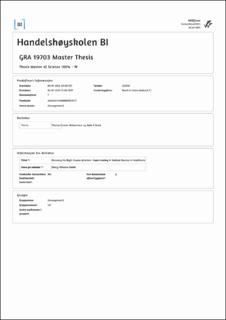Choosing the Right Course of Action: Implementing Al Medical Deuices in Healthcare
Master thesis
Permanent lenke
https://hdl.handle.net/11250/3095561Utgivelsesdato
2023Metadata
Vis full innførselSamlinger
- Master of Science [1621]
Sammendrag
To address the need for specialized treatment and optimize resource utilization,
the healthcare industry must undergo a comprehensive digital transformation.
Various healthcare departments are actively exploring alternative e-health services
and technologies. However, progress in this area has been slow due to challenges
related to a growing population, safety concerns, patient security, limited data
availability, overworked medical staff, and a decentralized organizational
structure. The future of AI is increasingly being labeled as the answer for tackling
the challenges ahead and improving overall efficiency and quality of services in
healthcare. However, the adoption rate has been slow compared to other countries.
To uncover the underlying reasons for Norway’s lagging position, we have
formulated the following research question: How can hospitals implement and
adopt AI technologies to improve hospital care and provide a more efficient
pathway for everyone in need of healthcare services? We also included a
sub-question: What are the challenges to implementing AI into public healthcare?
Our thesis aimed to unravel the possibilities of AI implementation in Norwegian
hospitals, investigating only AI technologies classified as “medical devices.” To
answer the research question(s), we chose a qualitative method using two research
projects developing machine learning algorithms for improving cancer diagnostics
and treatment optimization as case studies. The empirical findings were collected
through 14 semi-structured interviews and six unstructured interviews with people
from the two projects, the MIM and DoMore!, as well as other key experts from
related industries.
Based on our research, we hypothesized that successful AI implementation in
healthcare depended on seven identified factors that were investigated: (a) AI
algorithm/technology, (b) data access and structure, (c) interdisciplinary
collaborations, (d) legal and regulatory frameworks, (e) AI validation and
documentation, (f) procurement and economic considerations, and (g) competence
and leadership. The study suggests that the hypothesis was indeed true but that
each determinant differed in value depending on case-to-case differences. By
outlining the drivers and barriers to successful implementation, we provide an
alternative approach to help the healthcare sector implement AI. Although the abovementioned variables all play a crucial role in successfully
implementing AI in healthcare, we found that, based on the current healthcare
setting, one approach for complete AI integration could depend on three steps:
➢ Building a standardized platform for data transparency and availability
➢ A collaborative approach for mapping regulatory frameworks for AI
development
➢ Integrate a networked organizational structure with emphasis on AI leaders
and interdisciplinary collaborations
While the reflections in this thesis collectively integrate several barriers and
facilitators of successful AI implementation, the study found that to integrate AI
medical devices and avoid risks associated with the technology/algorithm, there
needs to be a common platform for sharing data between healthcare institutions,
their partners and third parties. This also necessitates the need for anonymization
and protection of patient privacy. Arguably, any uncertainties regarding the use of
AI could be avoided by exposing the AI models to more data and training them in
certified environments. The study further concludes that in terms of regulatory
frameworks, there needs to be a complete overview of the necessary steps for an
AI product development process to reach integration.
As indicated in the study, most developers and healthcare professionals find it
difficult to navigate through all the regulations of developing medical devices.
This requires extensive cross-industry collaborations and responsible agencies to
take action to enable developers and healthcare professionals to move forward
with suitable AI projects. Additionally, we found that integrating a networked
organizational structure with an emphasis on supporting AI leaders and
interdisciplinary collaborations fosters an innovative environment for AI
adoption. In this strategic initiative, we found that several of the identified barriers
would be mitigated by introducing a flexible approach to innovation that promotes
creativity and knowledge-sharing between industries. Finally, we found that
efforts to improve the AI adoption rate in healthcare are a collective undertaking.
It required the state and decision-making authority of hospitals to initiate a
detailed plan as well as assume a bigger role in leading the research projects
through the entire development process to complete implementation.
Beskrivelse
Masteroppgave (MSc) in Master of Science in Entrepreneurship and Innovation - Handelshøyskolen BI, 2023
